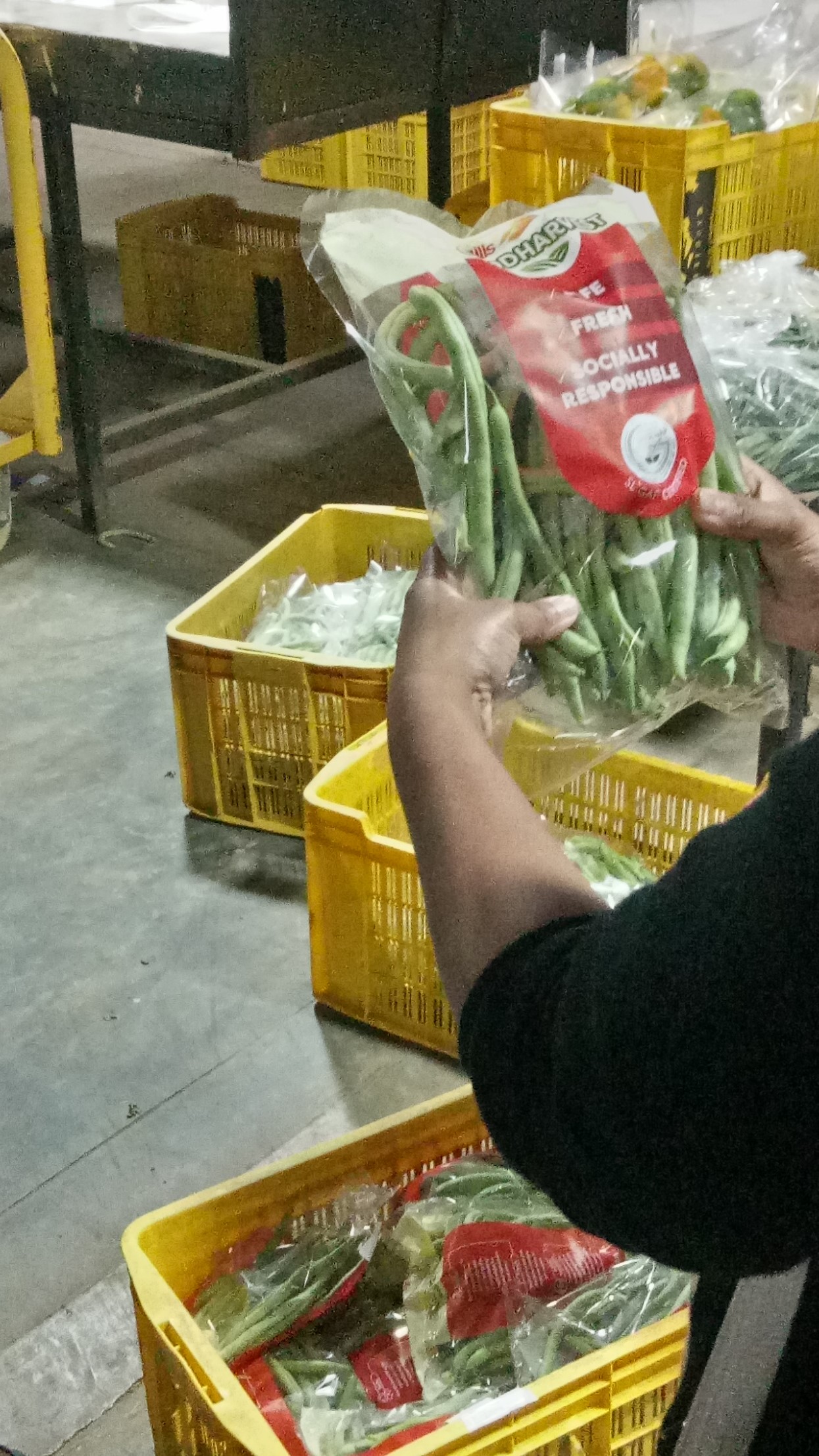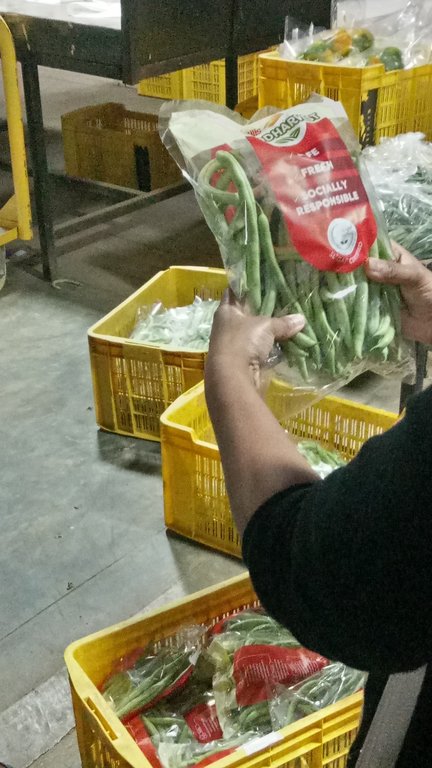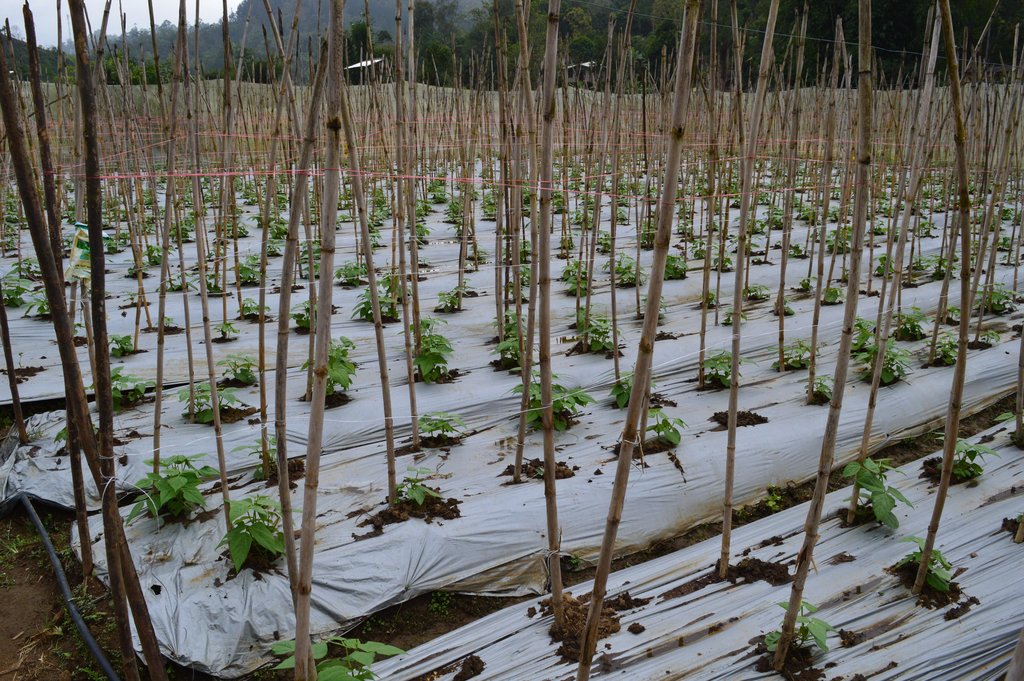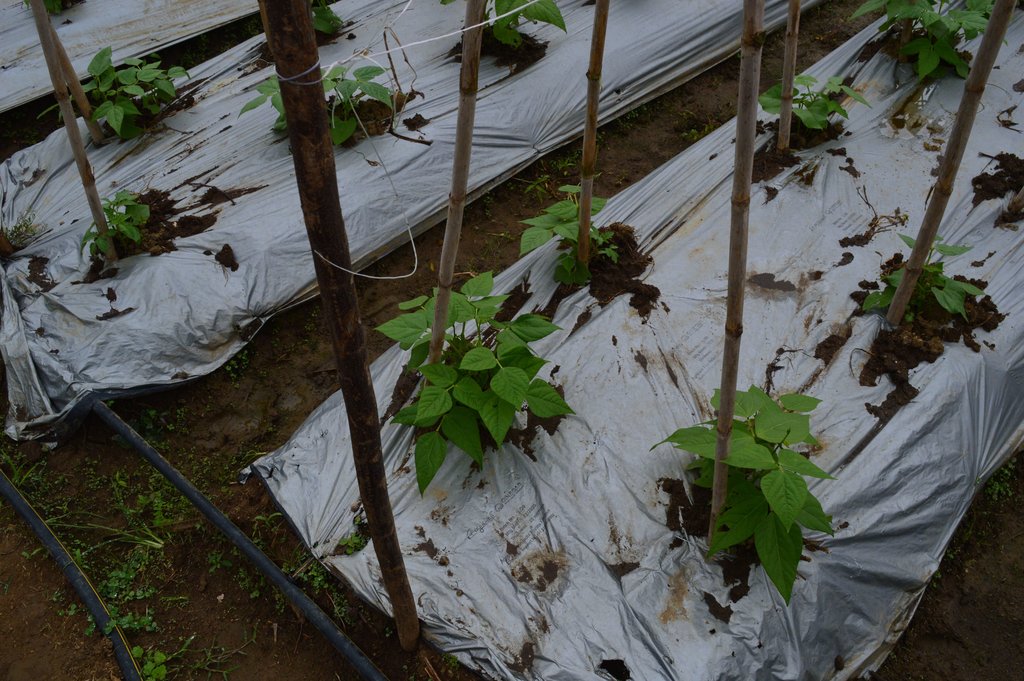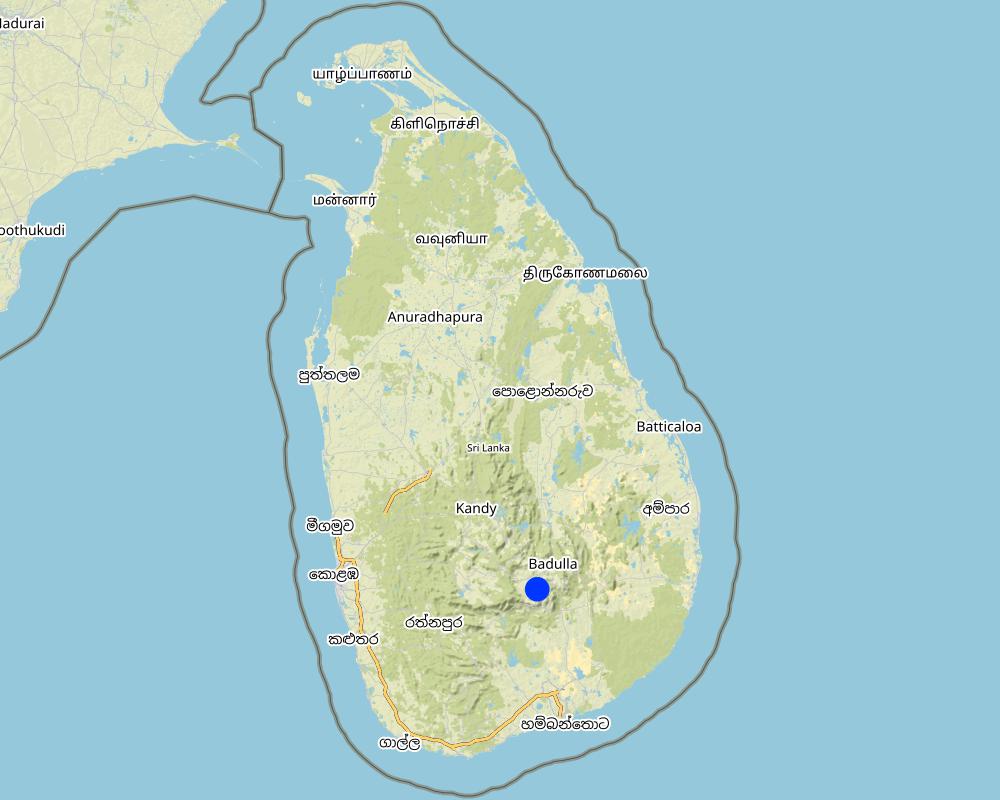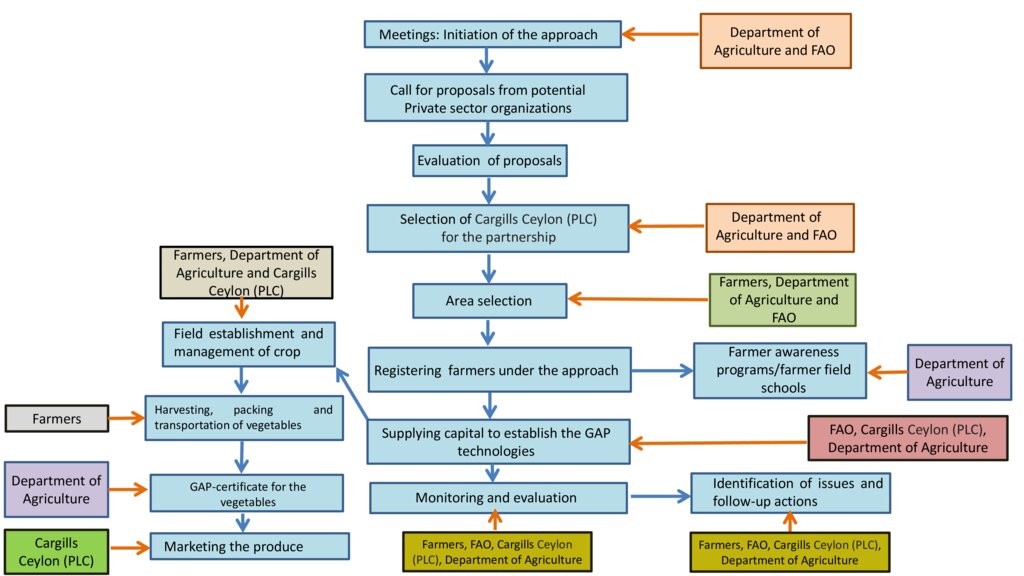Private-public partnership to promote Sustainable Land Management and Good Agricultural Practices among vegetable growers [ศรีลังกา]
- ผู้สร้างสรรค์:
- การอัพเดท:
- ผู้รวบรวม: Head Soil Science
- ผู้เรียบเรียง: –
- ผู้ตรวจสอบ: William Critchley
GAP Program
approaches_6229 - ศรีลังกา
ดูส่วนย่อย
ขยายทั้งหมด ย่อทั้งหมด1. ข้อมูลทั่วไป
1.2 รายละเอียดที่ติดต่อได้ของผู้รวบรวมและองค์กรที่เกี่ยวข้องในการประเมินและการจัดเตรียมทำเอกสารของแนวทาง
วิทยากรหลัก
ผู้ใช้ที่ดิน:
Leelarathna Herath Mudiyanselage
+94 713586312
Ketakela, Ambegoda, Bandarawela
ศรีลังกา
ผู้เชี่ยวชาญ SLM:
Karunathilaka D.L. Manoj
+9477 3992261
manoj.ka@cargillsceylon.com
Cargills (Ceylon) PLC
40, York Street, Colombo
ศรีลังกา
ผู้เชี่ยวชาญ SLM:
Jayaweera Tharindu
+94713586312
tmjanusha@gmail.com
Department of Agriculture, Sri Lanka
Agrarian Service Centre, Bandarawela
ศรีลังกา
ผู้เชี่ยวชาญ SLM:
Gunasena Nimal
+94714490338
Nimal.Gunasena@fao.org
Food and Agriculture Organization of United Nations
202, Bauddhaloka Mawatha, Colombo 00700
ศรีลังกา
ผู้ใช้ที่ดิน:
Bandara K.M.S.J Jayasiri
+94741066961
No. 178, Ketakela, Ambegoda, Bandarawela
ศรีลังกา
co-compiler:
Attanayake Chammi
(+)94 71 147 2288
chammiatt@agri.pdn.ac.lk / chammiattanayake@gmail.com
Department of Soil Science, Faculty of Agriculture, University of Peradeniya
Peradeniya, Sri Lanka
ศรีลังกา
co-compiler:
ชื่อของโครงการซึ่งอำนวยความสะดวกในการทำเอกสารหรือการประเมินแนวทาง (ถ้าเกี่ยวข้อง)
Rehabilitation of Degraded Agricultural Lands in Kandy, Badulla and Nuwara Eliya Districts in the Central Highlands of Sri Lankaชื่อของโครงการซึ่งอำนวยความสะดวกในการทำเอกสารหรือการประเมินแนวทาง (ถ้าเกี่ยวข้อง)
Food and Agriculture Organization of the United Nations (FAO) - อิตาลีชื่อของโครงการซึ่งอำนวยความสะดวกในการทำเอกสารหรือการประเมินแนวทาง (ถ้าเกี่ยวข้อง)
Faculty of Agriculture, University of Peradeniya, Sri Lanka (AGRI.PDN) - ศรีลังกาชื่อของโครงการซึ่งอำนวยความสะดวกในการทำเอกสารหรือการประเมินแนวทาง (ถ้าเกี่ยวข้อง)
Department of Agriculture, Sri Lanka (DOA) - ศรีลังกาชื่อของโครงการซึ่งอำนวยความสะดวกในการทำเอกสารหรือการประเมินแนวทาง (ถ้าเกี่ยวข้อง)
Cargills (Ceylon) PLC (Cargills) - ศรีลังกา1.3 เงื่อนไขที่เกี่ยวข้องกับการใช้ข้อมูลที่ได้บันทึกไว้ผ่านทาง WOCAT
วันที่เก็บรวบรวมข้อมูล (ภาคสนาม):
24/02/2022
ผู้รวบรวมและวิทยากรหลักยอมรับเงื่อนไขเกี่ยวกับการใช้ข้อมูลที่ถูกบันทึกผ่านทาง WOCAT:
ใช่
2. คำอธิบายของแนวทาง SLM
2.1 การอธิบายแบบสั้น ๆ ของแนวทาง
A private-public partnership overcomes constraints that vegetable farmers encounter when adopting novel SLM technologies and Good Agricultural Practices. The private sector helps with marketing, value addition, certification, and financial support. The public sector fulfils farmer training needs through (for example) Farmer Field Schools using digital platforms.
2.2 การอธิบายอย่างละเอียดของแนวทาง
การอธิบายอย่างละเอียดของแนวทาง:
This approach was implemented in vegetable growing lands in hilly and rolling terrain, where the average annual rainfall is relatively high: Wet zone (>2500 mm) Intermediate zone (1750-2500 mm-short dry periods). Controlling soil erosion is crucial in these regions. Further, overuse and misuse of agrochemicals are common among the farmers. On the other hand, farmers experience lack of market opportunities, lack of technical and financial support and water scarcity in the intermediate zone which restricts farming to 1 or 2 cropping cycles. This approach aims to support vegetable growers by providing financial and technical support to implement technologies to minimize soil erosion and increase fertilizer and water use efficiencies, while providing adequate market opportunities and product value addition.
In the field, the following technologies were implemented as a package: plastic mulch, terracing, drip irrigation systems, fertigation units and insect proof nets. Furthermore, capacity development programs were implemented along with continuous monitoring, financial support was provided to adopt the technologies. The market opportunity was expanded via value addition through “GAP-certification" (GAP = Good Agricultural Practices) and facilitating easy and secured access to market via private sector involvement.
By adopting this technological package farmers were able to reduce the fertilizer use by about 70-80 % via "fertigation" - that is fertilizer mixed in irrigation water. Further, the pest attacks and need of insecticides were significantly reduced due to insect proof nets. The weed growth was negligible due to the plastic mulch which reduced the labour cost significantly as previously, farmers used to control weeds manually. Soil erosion was minimal due to plastic mulch used over the contour terraces. The water use efficiency was improved via drip irrigation and the farming was not affected by the short drought periods. The overall cost reduction that the farmers experience by adopting this technological package was about 20%. Further, the yield increase was about 20%, which raised the profit by 30%. Proper use of pesticides with adequate safety measures and safe disposal of the pesticide containers are mandatory to be qualified for GAP-certification. Farmers that adopt this approach collect pesticide containers in a designated place in the farm.
The implementation of the approach was as follows:
1.Discussions between Food and Agriculture Organization of United Nations (FAO) and Department of Agriculture, Sri Lanka (DOA) to develop a private-public partnership (PPP).
2.Call for proposals from private sector supermarket owners and exporters.
3.The proposal of Cargills (Ceylon) PLC was accepted.
4.Areas with easy access to Cargill’s vegetable collection centers were selected for the pilot programme, namely Haguranketha and Nuwarleiya, Boralanda and Bandarawela.
5.Eighty progressive farmers who had been providing vegetables for the already established vegetable collection centers were selected for the initial program.
6.Farmer awareness programs and Farmer Field Schools were conducted on the technological package, the GAP certification process and market arrangements.
7.The technical package was installed in farmers’ fields. Farmers were supported financially to obtain raw materials and cover the capital cost (for polythene, drip irrigation systems, insect-proof nets and accessories, fertilizers and pesticides). The cost estimated to implement the package was Rs. 300,000 for quarter of an acre (Rs. 2.96 million/ha = approx. UD$ 8950/ha). Cargills and the FAO funded RDAL (Rehabilitation of degraded agricultural lands in the central highlands of Sri Lanka) shared 2/3 of the material cost. The rest of the cost was borne by the farmer. Cargills Bank provided low interest loans to farmers to cover their share of the capital cost.
8.Continuous monitoring and capacity development and motivational programs were implemented via field visits and WhatsApp groups.
9.GAP-certification was provided for the vegetables.
10.A market was provided by Cargills with a guaranteed 10% premium above the standard rate.
11.Alongside the implementation processes, other developments took place. These included: supply of fertilizers and pesticides to farmers and provision of study scholarships for children of the farmers by Cargills.
The limitations of the approach are as follows: first, reluctance of the farmers to follow the rigorous record-keeping process necessary to obtain the GAP-certification; second, the absence of a proper methodology to recycle or upcycle the pesticide containers; third, the on-going lack of consumer awareness about the GAP-certified products.
2.3 รูปภาพของแนวทาง
2.5 ประเทศ ภูมิภาค หรือสถานที่ตั้งที่ได้นำแนวทางไปใช้
ประเทศ:
ศรีลังกา
ภูมิภาค/รัฐ/จังหวัด: :
Bandarawela/Badulla District/Uva Province
ข้อมูลเฉพาะเพิ่มเติมของสถานที่ตั้ง:
Ambegoda Village
ความคิดเห็น:
Ambegoda village is located about 8 km away from Bandarawela town. Other than the studied site, this approach was implemented in Jaffna, Kilinochchi, Monaragala, Thabuttegama, Galenbindunuwewa, Boralanda, Adhikaarigama and Thanamalwila areas
Map
×2.6 วันที่เริ่มต้นและสิ้นสุดของแนวทาง
ระบุปีที่เริ่ม:
2019
2.7 ประเภทของแนวทาง
- ใช้โครงงานหรือแผนงานเป็นฐาน
2.8 เป้าหมายหรือวัตถุประสงค์หลักของแนวทาง
This approach aims to support vegetable growers by providing financial and technical support to implement technologies to minimize soil erosion and increase fertilizer and water use efficiencies, while providing adequate market opportunities and product value addition via GAP-certification.
2.9 เงื่อนไขที่เอื้ออำนวยหรือเป็นอุปสรรคต่อการนำเทคโนโลยีภายใต้แนวทางนี้ไปปฏิบัติใช้
การมีไว้ให้หรือการเข้าถึงแหล่งการเงินและบริการ
- เอื้ออำนวย
Farmers are encouraged to get financial support from the Cargills (Ceylon) PLC to implement their technological package
กรอบแนวทางในการดำเนินการด้านกฎหมาย (การถือครองที่ดิน สิทธิในการใช้ที่ดินและน้ำ)
- เอื้ออำนวย
The collaboration between government and private sector helped to build the trust among farmers about the approach
ความรู้เกี่ยวกับ SLM การเข้าถึงการสนับสนุนด้านเทคนิค
- เอื้ออำนวย
The knowledge gained on SLM practices obtained through farmer field schools was important for the success of the approach
ตลาด (จัดซื้อปัจจัยนำเข้า ขายผลิตภัณฑ์) และราคา
- เอื้ออำนวย
The GAP certified agricultural produce was purchased by Cargills (Ceylon) PLC for a higher price; hence many farmers were motivated to implement the technology in their fields
3. การมีส่วนร่วมและบทบาทของผู้มีส่วนได้ส่วนเสียที่เกี่ยวข้อง
3.1 ผู้มีส่วนได้ส่วนเสียที่เกี่ยวข้องในแนวทางนี้และบทบาท
- ผู้ใช้ที่ดินระดับท้องถิ่นหรือชุมชนระดับท้องถิ่น
Farmers
Farmers implement the technology in their fields
- ผู้เชี่ยวชาญ SLM หรือที่ปรึกษาการเกษตร
Agricultural Instructors (AI) of DOA
AIs organize farmer field schools and training programmes for farmers. They also visit the fields to guide, monitor and provide recommendations for the farmers for successful implementation of the approach. The experts connect with the farmers through WhatsApp groups, where the farmers can quickly find solutions for the issues. Also, it facilitated the peer learning among the farmers.
- ภาคเอกชน
Cargills (Ceylon) PLC
Cargills (Ceylon) PLC is the buyer of the fresh produce from farmers who practice this approach. The collection centre manager of the Cargills (Ceylon) PLC plays a critical role. He connects with the farmers from the field establishment of the technology package to packing and transporting the final produce to the collection centers.
- องค์การระหว่างประเทศ
FAO
FAO initiated the program and is one of the main coordinating bodies of the project of Rehabilitation of degraded agricultural lands in the central highlands of Sri Lanka (RDAL).
3.2 การเกี่ยวข้องของผู้ใช้ที่ดินระดับท้องถิ่นหรือชุมชนระดับท้องถิ่นในช่วงต่างๆของแนวทาง
| ความเกี่ยวข้องของผู้ใช้ที่ดินระดับท้องถิ่นหรือชุมชนระดับท้องถิ่น | ระบุผู้ที่มีส่วนเกี่ยวข้องและอธิบายกิจกรรม | |
|---|---|---|
| การริเริ่มหรือการจูงใจ | ไม่ลงมือ | Though the progressive farmers were selected from the farmers who sell their produce to the Cargills (Ceylon) PLC collection centres at the initial phase of the project, new farmers were motivated to implement the approach when they observed the success of the neighbouring farmers. |
| การวางแผน | ไม่มี | The planning phase of the approach totally governed by the RDAL project team with the assistance of the private and government sector stakeholders. |
| การดำเนินการ | จ่ายเงินหรือสนับสนุนจากภายนอก | Farmers directly involved with the implementation phase of the approach. |
| การติดตามตรวจสอบหรือการประเมินผล | ปฏิสัมพันธ์ | Farmers were actively involved with the monitoring and evaluation process of the approach by discussing the problem faced by them and finding solutions with the help of AIs. Farmers collectively shared their experience and those feedback helped for the evaluation process of the approach. |
| Expansion | จ่ายเงินหรือสนับสนุนจากภายนอก | The children of the farmers are given study scholarships by the private sector partner. |
3.3 แผนผังแสดงขั้นตอนการทำงาน (ถ้ามี)
คำอธิบาย:
The flow chart demonstrates the approach with the intervening steps of the Public and private sectors
ผู้เขียน:
Dr. Chammi Attanayake and Mr. Tharindu Kulasinghe
3.4 การตัดสินใจเลือกใช้เทคโนโลยี SLM
ระบุผู้ที่ทำการตัดสินใจเลือกเทคโนโลยีมากกว่าหนึ่งวิธีไปปฏิบัติใช้:
- ผู้เชี่ยวชาญ SLM เป็นผู้ตัดสินใจหลัก ที่ติดตามให้คำปรึกษากับผู้ใช้ที่ดิน
การอธิบาย:
Selection of technologies to be implemented in the approach was done based on the discussions between the FAO representatives, DOA officials and Cargills (Ceylon) PLC. AIs of DOA have been closely working with the farmers; hence, their experience was very helpful to select the best technologies to be implemented in farmer fields.
ระบุว่าการตัดสินใจตั้งอยู่บนพื้นฐานของ:
- การประเมินความรู้ SLM ที่ได้ทำการบันทึกไว้เป็นอย่างดี (การใช้ข้อมูลในการตัดสินใจ)
- ประสบการณ์และความคิดเห็นส่วนตัว (ไม่ได้ลงบันทึกไว้)
4. การสนับสนุนด้านเทคนิค การสร้างขีดความสามารถ และการจัดการด้านความรู้
4.1 การสร้างขีดความสามารถ / การอบรม
ได้มีการจัดอบรมให้แก่ผู้ใช้ที่ดินหรือผู้มีส่วนได้ส่วนเสียคนอื่น ๆ หรือไม่:
ใช่
ให้ระบุว่าใครเป็นผู้ได้รับการอบรม:
- ผู้ใช้ที่ดิน
รูปแบบการอบรม:
- กำลังดำเนินการ
- เกษตรกรกับเกษตรกร
- ใช้พื้นที่ทำการสาธิต
หัวข้อที่พูด:
Establishment and maintenance of GAP technology in farmer fields, irrigation management (drip irrigation), pests and disease management, fertilizer application through drip irrigation (fertigation), post-harvest technology, nursery management
ความคิดเห็น:
Training programs mainly focused on establishment and maintenance of technology package according to standards and identification of pest and disease problems. Training programs are held in fields as farmer field schools. Those training programs are organized and conducted by AIs of the DOA and Agricultural Officers of Cargills (Ceylon) PLC. A training program provides information from the establishment of the technological package to harvesting of the fresh produce
4.2 การบริการให้คำแนะนำ
ผู้ใช้ที่ดินมีการเข้าถึงการรับบริการให้คำปรึกษาหรือไม่:
ใช่
ระบุว่ามีบริการให้คำปรึกษาหรือไม่:
- ไปเยี่ยมชมสถานที่
การอธิบาย/แสดงความคิดเห็น:
AIs of DOA and agricultural officers of Cargills (Ceylon) PLC visit farmers frequently to guide farmers and train them for better management of the technologies in the field
4.3 การเสริมความแข็งแกร่งให้กับสถาบัน (การพัฒนาองค์กร)
สถาบันได้รับการจัดตั้งขึ้นมาหรือเสริมความแข็งแกร่งโดยแนวทางนี้หรือไม่:
- ไม่
4.4 การติดตามตรวจสอบและประเมินผล
การติดตามตรวจสอบและประเมินผลเป็นส่วนหนึ่งของแนวทางหรือไม่:
ใช่
ถ้าตอบว่าใช่ แสดงว่าการจัดเตรียมเอกสารนี้มุ่งหวังที่จะเอาไปใช้สำหรับการติดตามตรวจสอบและประเมินผลใช่หรือไม่:
ใช่
4.5 การวิจัย
การวิจัยเป็นส่วนหนึ่งของแนวทางหรือไม่:
ไม่ใช่
5. การสนับสนุนด้านการเงินและวัสดุอุปกรณ์
5.1 ระบุงบประมาณประจำปีสำหรับแนวทาง SLM นี้
ระบุงบประมาณประจำปีสำหรับแนวทาง SLM นี้ เป็นหน่วยดอลลาร์สหรัฐ:
165000.00
แสดงความคิดเห็น (แหล่งของการระดมทุน ผู้บริจาคคนสำคัญ):
FAO and Cargills (Ceylon) PLC are main sources of funding to implement the approach
5.2 การสนับสนุนด้านการเงิน / วัสดุอุปกรณ์ให้แก่ผู้ใช้ที่ดิน
ผู้ใช้ที่ดินได้รับการสนับสนุนด้านการเงิน / วัสดุอุปกรณ์ไปปฏิบัติใช้เทคโนโลยีหรือไม่:
ใช่
ถ้าใช่ ให้ระบุประเภทของการสนับสนุน เงื่อนไขและผู้จัดหามาให้:
At the implementation, the farmers receive materials worth of 260,000 LKR, which consists of drip irrigation system, plastic mulch and insect proof net. This covers 2/3 of the cost of implementation. The rest of the cost, mostly the labor cost, is borne by the farmer. The farmer was given the choice of receiving a low interest loan through Cargills Agro-development Company and Cargills Bank, the subsidiaries of Cargillls (Ceylon) PLC to cover their share of the capital cost.
5.3 เงินสนับสนุนสำหรับปัจจัยนำเข้า (รวมถึงแรงงาน)
- อุปกรณ์
| ระบุปัจจัยนำเข้าที่ได้รับการสนับสนุน | เห็นด้วยระดับไหน | ระบุเงินสนับสนุน |
|---|---|---|
| เครื่องมือ | ได้รับการช่วยเหลือทางการเงินแบบเต็ม | Drip irrigation system (pipes, nozzles, pumps, filters, water tank) Insect proof net Plastic materials for the mulch |
ถ้าแรงงานโดยผู้ใช้ที่ดินเป็นปัจจัยนำเข้าที่มีอยู่มากมาย ระบุด้วยว่าเนื่องจาก:
- จ่ายเป็นเงินสด
5.4 เครดิต
มีการจัดหาเครดิตมาให้ภายใต้แนวทาง SLM หรือไม่:
ใช่
ถ้าใช่ ระบุเงื่อนไข (อัตราดอกเบี้ย การชำระคืน):
The interest rate of the loan is 8%, repayable in 2 years with a grace period of 6 months
ระบุผู้ให้เครดิต:
The loan is provided through Cargills Agro-development Company and Cargills Bank, subsidiaries of Cargillls (Ceylon) PLC
ระบุผู้รับเครดิต:
Farmers
5.5 แรงจูงใจหรือเครื่องมืออื่น ๆ
แรงจูงใจหรือเครื่องมืออื่น ๆ ได้ถูกนำไปใช้ส่งเสริมการใช้เทคโนโลยี SLM หรือไม่:
ใช่
ถ้าใช่ ระบุ:
If yes, specify: Cargills (Ceylon) PLC prioritize the project farmers when purchasing the produce at collection centres and also they provide packing and branding materials under Cargill’s Good Harvest Brand. A 20% extra payment, above the normal purchasing price, is made for GAP-Certified, ‘Good Harvest’ branded products, subject to a minimum and maximum amounts of Rs. 10.00 and Rs. 30.00 per kg respectively.
6. การวิเคราะห์ผลกระทบและการสรุป
6.1 ผลกระทบของแนวทาง
ทำให้ผู้ใช้ที่ดินระดับท้องถิ่นมีอำนาจขึ้น ปรับปรุงการเข้าร่วมของผู้มีส่วนได้ส่วนเสียให้ดีขึ้นหรือไม่:
- ไม่ใช่
- ใช่ เล็กน้อย
- ใช่ ปานกลาง
- ใช่ อย่างมาก
The stakeholder’s participation is encouraged through farmer field schools and advisory services. The collective action of farmers to solve field problems themselves is observed through such programs.
ช่วยให้ผู้ใช้ที่ดินนำเอาเทคโนโลยี SLMไปใช้และบำรุงรักษาสภาพไว้ได้หรือไม่:
- ไม่ใช่
- ใช่ เล็กน้อย
- ใช่ ปานกลาง
- ใช่ อย่างมาก
The technology package introduced for farmers, insect proof net, drip irrigation system and plastic mulch, through the approach aims for irrigation water conservation; mitigate soil erosion and pest and disease attacks.
ปรับปรุงความร่วมมือกันและการดำเนิน งานของ SLM ได้อย่างมีประสิทธิผลหรือไม่:
- ไม่ใช่
- ใช่ เล็กน้อย
- ใช่ ปานกลาง
- ใช่ อย่างมาก
The technology package of the approach is ultimately reducing the cost for labour, irrigation, pesticides and other agrochemicals.
ระดมกำลังหรือปรับปรุงการเข้าถึงแหล่ง เงินทุนสำหรับการดำเนินการ SLM หรือไม่:
- ไม่ใช่
- ใช่ เล็กน้อย
- ใช่ ปานกลาง
- ใช่ อย่างมาก
Farmers receiving a loan to implement the approach in their fields.
ปรับปรุงความรู้และความสามารถของผู้ใช้ที่ดินในการดำเนินการ SLM หรือไม่:
- ไม่ใช่
- ใช่ เล็กน้อย
- ใช่ ปานกลาง
- ใช่ อย่างมาก
The farmers were trained on SLM practices through extension programs (farmer field schools and advisory services).
ทำให้ผู้ใช้ที่ดินระดับท้องถิ่นมีอำนาจขึ้น ปรับปรุงการเข้าร่วมของผู้มีส่วนได้ส่วนเสียให้ดีขึ้นหรือไม่:
- ไม่ใช่
- ใช่ เล็กน้อย
- ใช่ ปานกลาง
- ใช่ อย่างมาก
Active involvement of public and private sector participation is a distinct feature of the approach
ส่งเสริมให้เยาวชนหรือบุตรหลานของผู้ใช้ที่ดินให้เข้าร่วมใน SLM:
- ไม่ใช่
- ใช่ เล็กน้อย
- ใช่ ปานกลาง
- ใช่ อย่างมาก
The interest on participation of young generation in the approach is significant due to implementation of novel technologies. And also because of the deviation of the traditional vegetable cultivation practices.
นำไปสู่ความมั่นคงด้านอาหารหรือปรับปรุงโภชนาการให้ดีขึ้น:
- ไม่ใช่
- ใช่ เล็กน้อย
- ใช่ ปานกลาง
- ใช่ อย่างมาก
The approach helps to improve the yield and the quality of the produce
ปรับปรุงการเข้าถึงตลาดหรือไม่:
- ไม่ใช่
- ใช่ เล็กน้อย
- ใช่ ปานกลาง
- ใช่ อย่างมาก
The harvest of the farmers who implement the technologies, is purchased by the Cargills (Ceylon) PLC for a reasonably higher price.
ปรับปรุงความสามารถของผู้ใช้ที่ดินในการปรับตัวให้เข้ากับการเปลี่ยนแปลงของสภาพภูมิอากาศหรือสภาพที่รุนแรงและภัยพิบัติหรือไม่:
- ไม่ใช่
- ใช่ เล็กน้อย
- ใช่ ปานกลาง
- ใช่ อย่างมาก
Farmers require less irrigation water when cultivating under drip irrigation and plastic mulch technologies. Hence the cultivation can proceed even under a drought or water scarce conditions.
6.2 แรงจูงใจหลักของผู้ใช้ที่ดินเพื่อที่จะนำ SLM ไปปฏิบัติใช้
- การผลิตที่เพิ่มขึ้น
Vegetable production increases due to better crop management practices, improved irrigation efficiency and reduced pests and disease damages
- กำไร (ความสามารถ) อัตราส่วนค่าใช้จ่ายต่อผลประโยชน์ที่เพิ่มขึ้น
Cargills (Ceylon) PLC prioritizes the GAP certified farmers and buy vegetables for higher prices with contrast to other farmers. Hence, vegetable cultivation under the approach is a sort of value addition for the fresh produce. Moreover, the labour cost for field establishment of crop, irrigation, weeding and pesticide application is less and increase the profitability of cultivation
- การเสื่อมของที่ดินลดลง
The drip irrigation system and the plastic mulch help to increase the irrigation water use efficiency. Plastic mulch also can be considered as a soil conservation measure and it reduces weed growth.
- ความเสี่ยงของภัยพิบัติลดลง
Farmers can cultivate even under water scarce or drought conditions and reduces the risk of crop failure due to water scarcity
- ภาระงานลดลง
The labour requirement for irrigation, planting, weeding, pesticide application is less under the GAP approach
- การจ่ายเงินหรือการช่วยเหลือ
The farmers who follow GAP are getting higher price for vegetables compared to other farmers (10% higher payment, than the normal purchasing price)
- จิตสำนึกด้านสิ่งแวดล้อม
The approach reduces the use of pesticides and irrigation water and reduce soil erosion.
- ความรู้และทักษะ SLM ที่เพิ่มพูนขึ้น
Farmers are getting new knowledge on technologies that utilize resources more efficiently and they are getting skills on an establishment and managing modern technology package.
6.3 ความยั่งยืนของกิจกรรมของแนวทาง
ผู้ใช้ที่ดินสามารถทำให้สิ่งต่างๆ ที่ได้ปฏิบัติใช้โดยแนวทางนี้ยั่งยืนได้หรือไม่ (โดยไม่มีการสนับสนุนจากภายนอก):
- ใช่
ถ้าตอบว่าใช่ ให้อธิบายว่าอย่างไร :
The assurance of the market for value added products via well-established market chain of the Cargills (Ceylon) PLC is a major reason behind the sustainability of the approach.
6.4 จุดแข็งและข้อได้เปรียบของแนวทาง
| จุดแข็ง / ข้อได้เปรียบของแนวทางในทัศนคติของผู้ใช้ที่ดิน |
|---|
| Increased vegetable production compared to the conventional and traditional agricultural management practices. |
| Reduced cost for labour for establishment of the crop, irrigation, pesticide application, weeding and for other maintenance activities. |
| Financial benefit obtained by the lower requirement of fertilizers and agrochemicals |
| The number of cropping cycles was increased in regions where short drought periods exist. |
| Selling the produce for a higher price due to value addition via certification. |
| Minimizes the involvement of middlemen in selling farmer’s produce for market helps to increase the farmer’s profit and also benefits the seller, Cargills (Ceylon) PLC, ultimately the consumer. |
| จุดแข็ง / ข้อได้เปรียบของแนวทางในทัศนคติของผู้รวบรวมหรือวิทยากรหลัก |
|---|
| Minimum soil erosion due to use of plastic mulch and terraces. The lands are susceptible for erosion by water due to relatively high rainfall intensity and the hilly-rolling terrain. The control of soil erosion is curial to maintain sustainable land use in the region. |
| The inorganic fertilizer use was reduced by 70-80%. Use of pesticides was significantly reduced. Soil nutrient enrichment and pollution of soil and water sources were minimal. |
| Increased vegetable production helps for the food security of the country. |
| Improves the quality of the fresh produce. |
| Increased water use efficiency. |
| Uplifting the quality of life among the rural farming community. |
| Attraction of young community for farming. |
6.5 จุดอ่อน / ข้อเสียเปรียบของแนวทางและวิธีในการแก้ไข
| จุดอ่อน / ข้อเสียเปรียบในทัศนคติของผู้ใช้ที่ดิน | สามารถแก้ไขปัญหาได้อย่างไร |
|---|---|
| Maintaining the technology under field conditions is difficult due to the cause of natural factors (eg: High winds break the insect proof net). | The effect of natural factors on structures of the technology can be minimized by establishing those structures suitable for specific natural conditions. Live wind breakers (Rows of trees) can be established. |
| Discard of plastic materials (insect proof net and plastic mulch) when their lifespan is over. | Implementation of waste disposal method is required and need to look for possible recycling options. |
| จุดอ่อน / ข้อเสียเปรียบในทัศนคติของผู้รวบรวมหรือวิทยากรหลัก | สามารถแก้ไขปัญหาได้อย่างไร |
|---|---|
|
The farmers of older generation are somewhat reluctant to adopt the approach, mainly because of rigorous record keeping process |
This can be overcome by conducting advisory programs and extension services targeting specific groups of farming communities |
| Requirement of more financial support to cover the capital | Provide more subsidies and loans |
| Lack of consumer awareness about "Gap-certified products" | Advertising |
7. การอ้างอิงและการเชื่อมต่อ
7.1 วิธีการหรือแหล่งข้อมูล
- ไปเยี่ยมชมภาคสนาม การสำรวจพื้นที่ภาคสนาม
1 field visit
- การสัมภาษณ์กับผู้ใช้ที่ดิน
2 interviews
- การสัมภาษณ์ผู้เชี่ยวชาญด้าน SLM หรือผู้ชำนาญ
4 interviews
- การเก็บรวบรวมมาจากรายงานและเอกสารที่มีอยู่
4 documents
7.2 การอ้างอิงถึงสิ่งตีพิมพ์
ชื่อเรื่อง ผู้เขียน ปี ISBN:
Crop production under GAP certification, Seed certification service, Department of Agriculture, Sri Lanka, 2019 (in Sinhala language)
ช่องทางในการสืบค้น และราคา:
Freely available at the Department of Agriculture, Sri Lanka Website: https://doa.gov.lk/scs-gap-certification/
ชื่อเรื่อง ผู้เขียน ปี ISBN:
Good Agricultural Practices for Solanaceae family crops, Ministry of Agriculture and Department of Agriculture, Sri Lanka, 2016 (in Sinhala language)
ช่องทางในการสืบค้น และราคา:
Freely available at the Department of Agriculture, Sri Lanka Website: https://doa.gov.lk/scs-gap-certification/
ชื่อเรื่อง ผู้เขียน ปี ISBN:
Sustainable Land Management through GAP certification (Project proposal), Cargills (Ceylon) PLC, April-2019
7.3 เชื่อมโยงกับข้อมูลที่มีอยู่บนออนไลน์
ชื่อเรื่องหรือคำอธิบาย:
Good agriculture practices (GAP) certification (in Healthy Soil Matters). Food and Agriculture Organisation of United Nations, Sri Lanka
URL:
https://sricat.net/images/Healthy-Soil-Matters---English-compressed.pdf
ชื่อเรื่องหรือคำอธิบาย:
An interview on implementation of the approach among vegetable cultivating farmers in upcountry. It gives information on involvement and roles of different sectors to popularize the approach among farmers.
URL:
https://www.youtube.com/watch?v=qChXPYnb0Wc
ชื่อเรื่องหรือคำอธิบาย:
Sl-GAP certification portal
URL:
http://www.slgap.doa.gov.lk/
ลิงก์และโมดูล
ขยายทั้งหมด ย่อทั้งหมดลิงก์
ไม่มีลิงก์
โมดูล
ไม่มีโมดูล


